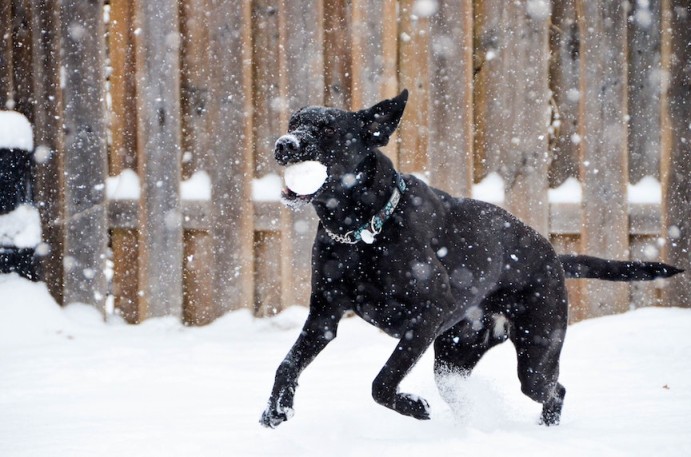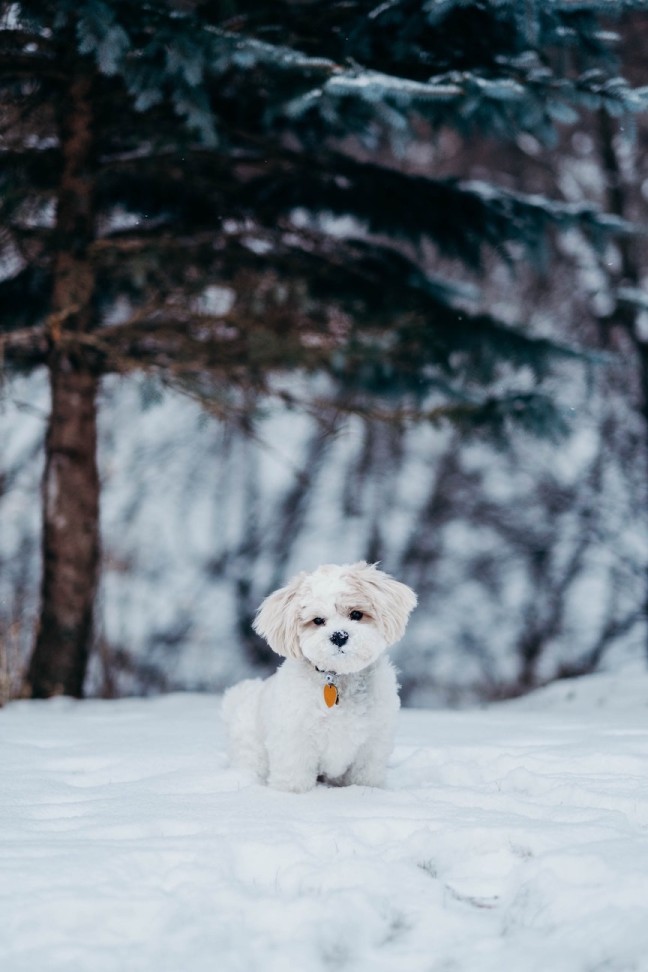5 Tips to Protect Your Dog’s Paws this Winter
Posted: 12/20/2022 | BY: Erin Cain | Categories: Uncategorized
Just as people need protection from the elements when they go outside in the winter, your dog does, too. Canines are particularly susceptible to issues with their paws when the temperatures drop and the snow begins to fly. With knowledge and some preventative measures, you can ensure that your pup enjoys winter without injuries to her feet. Here are 5 tips to protect your dog’s paws this winter season.

1. Groom and moisturize your dog’s feet.
Every day should be a spa day for your dog, especially during the dry, cold, harsh winter. The wet, snowy, or icy conditions outside expose her paws to the elements. Balls of snow and ice can quickly form on the feet, making it painful for your dog to walk. Paw pads often dry out due to exposure and become cracked, and sometimes this situation leads to frostbite.
You can spare your pup any winter discomfort by keeping her feet groomed and moisturized. Trim your dog’s nails regularly, as long nails can break when a dog runs through snow or on ice and cause injury. The same goes for paw hair between your pup’s toes. Keeping these hairs trimmed short makes it less likely that ice balls will get packed into your dog’s feet; it will also limit chemicals from sticking to the paw pad area.
2. Wash your pup’s paws after walks.
Speaking of chemicals, people throw a lot of them out onto streets, sidewalks, and driveways during the winter. Avoiding rock salt or other harsh chemically-treated surfaces is nearly impossible, so be ready to wash your dog’s feet once you return inside. Either keep a bowl of warm water and a towel by the door, use dog wipes on her paws, or take your pup to the bathtub and gently spray her feet down. Don’t let your dog lick the salt off her paws as it is toxic and can cause gastrointestinal upset.
You can care for your dog’s paws on your property by using a pet-friendly, non-toxic ice melt product. Also, watch for any antifreeze on the ground where your dog may walk and roam. Many people use antifreeze to winterize their vehicles, and it doesn’t take much to have a spill or leak on the ground. Unfortunately, antifreeze tastes good to dogs, and tiny amounts of it are fatal to canines if ingested. About five tablespoons of antifreeze can kill a medium-sized dog. Always wash your dog’s paws after she has been outside in the winter.
3. Protect the paws with boots and balms.
Soaked, wet, and washed paws can easily lead to sore, dry, and cracked paw pads. Protect those cute paws with dog boots, which minimize your dog’s contact or exposure to snow, ice, and potential ground chemicals. Use boots that properly fit your dog, and give her time to get accustomed to the strange feeling and weight on her feet.
If boots aren’t your dog’s style, you can use paw balm or another petroleum-based jelly product to keep those paws healthy. The balm helps create a protective barrier so that the ice, salt, and snow can’t get caught between your dog’s toes and in her paw hair. Additionally, paw balm keeps the pads moisturized, presenting painful dryness and cracking from occurring.

4. Clear a front or backyard path.
For quick puppy potty breaks, shovel out a flat area or path in the snow for your dog to do her duty. This action lessens the likelihood of too much snow sticking to your dog’s paws. You may even consider laying down some straw in this area to offer an additional way to keep the snow off your pup’s feet.
5. Keep walks short and sweet.
When it’s bitterly cold out and you’re uncomfortable, your pup likely is, too. In bitterly cold weather, take shorter and more frequent dog walks. Your dog can be at risk for hypothermia or frostbite if she’s outside for too long. Certain breeds are more susceptible to the cold than others, so pay attention to your dog’s behavior in cold weather. Not sure how cold is too cold for your dog? Talk with your veterinarian for advice.
Let it snow — safely — for your dog this winter.
Play it safe this winter, and take good care of your pup’s delicate paws. Of course, no matter how hard pet parents try to keep their furkids safe, accidents do happen. If your pet doesn’t have pet insurance, you can get a free personalized pet insurance quote and find the right policy for your budget. Let it snow, safely, for your canine companion this season.
References:
- Wisconsin Pet Care. (2016). The Dangers of Rock Salt on Dogs Paws — What to Know. Retrieved from https://wisconsinpetcare.com/the-dangers-of-rock-salt-on-dogs-paws/
- Washington State University College of Veterinary Medicine. (n.d.). Dog Antifreeze poisoning. Retrieved from https://www.vetmed.wsu.edu/outreach/Pet-Health-Topics/categories/miscellaneous-health-care-topics/antifreeze-poisoning
- Woodward, A. (2019). How to protect dogs and pets from hypothermia and frostbite. Retrieved from https://www.businessinsider.com/how-protect-dogs-pets-frostbite-hypothermia-2019-3
- Tractive. (2020). How cold is too cold for dogs? Retrieved from https://tractive.com/blog/en/safety/tips-for-dogs-and-cold-weather-in-winter
Disclaimer
The information contained on this blog is intended for informational and educational purposes only and should not be construed as medical advice. It is not a substitute for professional veterinary care. Always consult with your veterinarian before making any changes to your pet's health care or treatment plan.
The authors of this blog are not veterinarians and do not claim to be experts in pet health. The information provided here is based on our own experiences and research, as well as information from reputable sources. However, we cannot guarantee the accuracy or completeness of this information.
We encourage you to do your own research and consult with your veterinarian before making any decisions about your pet's health.
Previous post
8 Ways to Pet-Proof Your Christmas TreeNext post
Protecting Your Small Dog From CoyotesCompare top pet insurance providers plans.
Enter your dog’s age in years and months to calculate their age equivalent to human years.
Calculate your dog’s ageEnter your cat’s age in years and months to calculate their age equivalent to human years.
Calculate your cat’s age